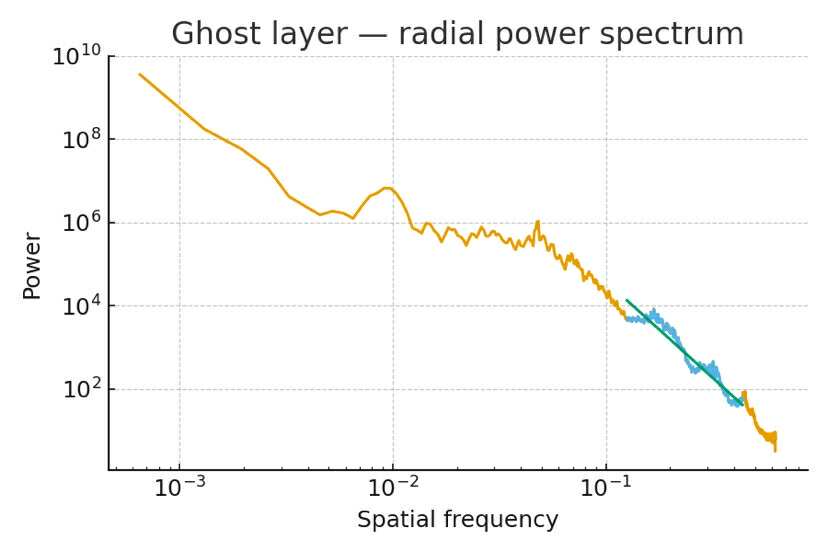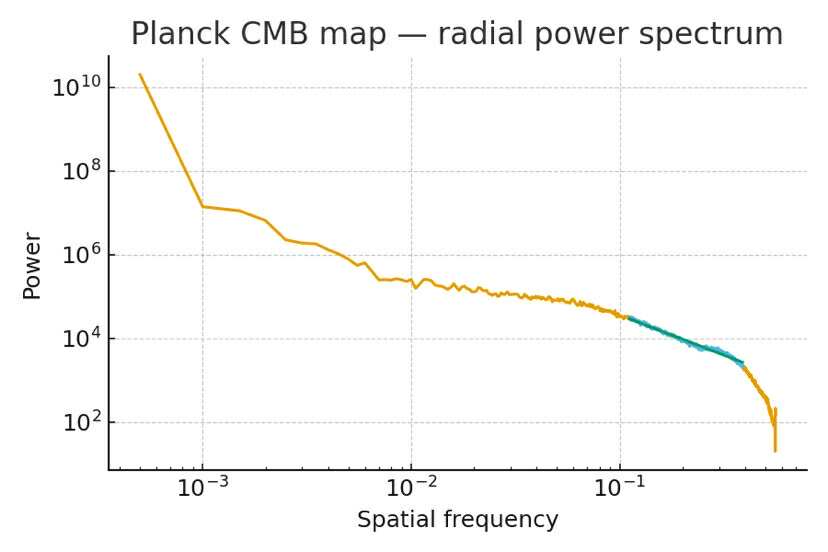Radial Power Spectra: Quantifying the Pi Matrix Across Scales
By James Johan Sebastian Allen — PatternFieldTheory.com • Last updated: 2025-10-05
Images from field ion microscopy (FIM), transmission electron microscopy (TEM), scanning tunneling / atomic force microscopy (STM/AFM) — and even full-sky maps — contain hidden structure in their frequency domain. By computing the radial power spectrum we can operationally quantify coherence, scale-coupling, and fractal-like behavior attributed in PFT™ to the Pi Matrix, from sub-nanometer lattices to sky-scale maps.
1) Pipeline — from pixels to $P(k)$
- Preprocess: grayscale/intensity image $I(x,y)$; remove large-scale gradients (high-pass or polynomial detrend); apply apodization (Hann/Hamming) to reduce edge leakage.
- Fourier transform: compute $F(k_x,k_y)=\mathcal{F}\{I(x,y)\}$ and the 2D power $P(k_x,k_y)=|F(k_x,k_y)|^2$.
- Radial average: bin by $k=\sqrt{k_x^2+k_y^2}$ to obtain the 1D spectrum $P(k)=\langle |F|^2\rangle_\theta$.
- Fit slope: on log–log axes, fit a line to $\log P$ vs. $\log k$ over a chosen inertial band to estimate the exponent $\beta$.
Fourier power: \( P(k_x,k_y)=|F(k_x,k_y)|^2 \).
Radial spectrum: \( P(k)=\langle P(k_x,k_y)\rangle_{\theta} \) with \( k=\sqrt{k_x^2+k_y^2} \).
2) Interpreting slopes
In many textures, \(P(k)\propto k^{-\beta}\). Within PFT’s framing, steeper slopes (larger \(\beta\)) indicate stronger long-range coherence (energy concentrated at low spatial frequencies), while shallower slopes suggest more local structure.
Different communities use different conventions. For self-affine 2D fields and surfaces, \(\beta\) relates to a Hurst-like exponent \(H\) via forms such as \( \beta \approx 2H+E \) (with \(E\) the embedding dimension used for the PSD), while “effective fractal dimension” \(D\) is defined contextually (e.g., for surfaces, \(D\approx E+1-H\)). In this article we use \(\beta\) primarily as a coherence scale index; any quoted \(D\) should state the convention and embedding explicitly.
3) Case sketches
Pre-correction halo
Early TEM/FIM images sometimes show halos/blur. PFT interprets these as a living cascade: resonance updating faster than optics can freeze. Radial spectra typically show enhanced low-$k$ power and a persistent slope.

Corrected lattice
With aberration correction, the motion freezes into a crisp lattice. High-$k$ power is suppressed; the radial slope flattens at the upper band — a Zeno frame snapshot in PFT language.

Ghost / logical layer
Subtle understructures (post-processing residuals or phase-like “ghosts”) can retain scale-invariant slopes, interpreted as a guiding logical layer in PFT’s ontology.

Blurry pre-correction
Before correction, blurred cascades often show strong power across decades in \(k\), consistent with active resonance/transport.

4) From atoms to sky maps
The same pipeline applies to large-scale maps (e.g., full-sky intensity/polarization). While the geometry differs (spherical harmonics \(C_\ell\) versus planar \(P(k)\)), both quantify how power distributes with scale. In PFT, similar slope behaviors across domains are taken as suggestive of a common substrate (Pi Matrix) — a hypothesis to be tested with consistent masks, beams, and noise models.
5) Reproducibility checklist
- State the image source and pixel scale (e.g., nm/pixel, arcmin/pixel).
- Document detrending, windowing, and any deconvolution/PSF handling.
- Publish binning scheme for \(k\) and the exact fit band used for \(\beta\).
- Provide confidence intervals for \(\beta\) (e.g., robust linear fit in log–log, bootstrap over tiles).
- For sky maps: report masks, beams, and convert \(C_\ell \leftrightarrow P(k)\) only with explicit approximations.
6) Compact formulas (operational)
\( F(k_x,k_y)=\mathcal{F}\{I(x,y)\}, \quad P(k_x,k_y)=|F(k_x,k_y)|^2 \)
\( P(k)=\langle P(k_x,k_y)\rangle_{\theta}, \quad P(k)\propto k^{-\beta} \)
Optional self-affinity sketch (declare convention): \( \beta \approx 2H + E \), with \(E\) the embedding used for the PSD. Use \(\beta\) as your primary reported metric unless a specific fractal-dimension convention is warranted and clearly stated.
Conclusion
Radial power spectra bridge images and mathematics. Their slopes and scale-dependence provide a compact fingerprint of coherence. In the PFT view, recurring slope behavior across domains is consistent with a universal conversion substrate (Pi Matrix), while instrument specifics (PSF, masks, windows) explain deviations. The method is simple, portable, and falsifiable.